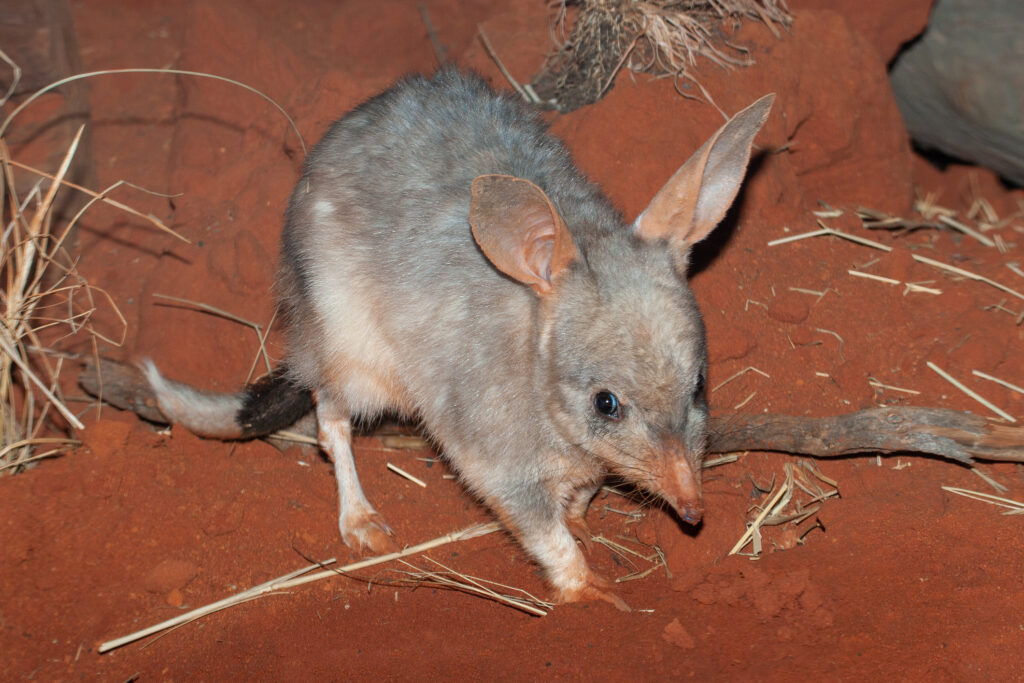The introduction of rabbits has had a devastating impact on Australian native flora and fauna.
However, their role as the traditional European symbol of fertility and new life has made it difficult for us to see them as destructive pests.
Come Easter time, there has been some effort to ‘replace’ the Easter Bunny with Australian native species such as bandicoots, bilbies and bettongs. But any consumer of Easter chocolate can tell you that the rabbit still reigns supreme.
So it’s safe to say that Australians have a complicated love-hate relationship with rabbits. And as it turns out, so do our native marsupials.
HOPPING OPPORTUNISTS
In the early 1900s, the WA government built a 1,700km rabbit-proof fence to try to keep them out. Spoiler alert – it didn’t work.
The speed at which rabbits spread across Australia is believed to be faster than any other colonising animal in the world.

Rabbits around a water trough in 1938 | M W Mules, CSIRO via Wikimedia Commons
Dr Anthony Rendall is a conservation science lecturer at Deakin University.
He says the European rabbits spread so quickly because the Australian climate and landscape was well-suited for them.
“There was high human investment to get them established to begin with,” says Anthony.
“Hunting was the primary motivation. And there was a lot of persecution of our native predators, which helped them a lot.”
While the damage caused by rabbits and the preservation of native species have been well studied, research into specific interactions between the two has been lacking.
QUALITY ALONE TIME
New research led by ecologist and site ranger Georgia Randall, looked into the interaction between European rabbits and native marsupials at Mt Rothwell Conservation Reserve.
Mt Rothwell is the second-largest ecosystem in Victoria that’s free from introduced predators.
By using predator-free reserves, the research team eliminated the influence of invasive predators like cats and foxes. Native predators such as quolls and birds of prey still inhabit the areas.
“Fenced or island reserves are the only real option for studying [these marsupials] in high enough numbers,” says Georgia.

Georgia Randall setting up a remote-sensing camera for the study | Georgia Randall of Mt Rothwell
They compared two population zones of marsupials: one housed with rabbits, the other without.
The chance to conduct this study within the same habitat made it very important and valuable.
“These days, rabbit-free areas are really rare,” says Anthony.
SOCIALLY AWKWARD
The study found that while bandicoots tried to avoid their European housemates, they didn’t resort to moving out.
The bandicoots altered the timing and duration of their foraging when rabbits were around. They were active later at night and spread out over longer hours.
But they still continued to occupy the same areas.
This could be a behavioural adaptation to avoid competition or in response to food and shelter availability.
RELUCTANT ROOMMATES
Rabbits provide alternative prey for feral foxes and cats. But according to Anthony, the invasive predators probably aren’t too picky.
"We think they attack rabbits more because they’re more abundant, and they probably just shift to bandicoots when bandicoots become more abundant," he says.
In the absence of invasive predators, bunnies and bandicoots seem able to coexist. But bandicoots are overall better off without rabbits in their neighbourhood.
In general, rabbits tend to overgraze vegetation and degrade soil quality. This increases weed growth and erosion, further limiting habitat biodiversity and food availability.
The study concluded that rabbit control remains the best outcome for native Australian mammals.
Georgia says we need more research into what influences native mammal behaviour, if we are to better understand them.
She’s also firmly all for Team Easter Bandicoot over Team Easter Bunny.
"I definitely think Australian culture needs to shift," says Georgia.
“Any extra awareness or education about our native marsupials is important.”













